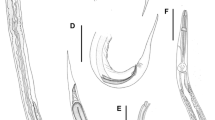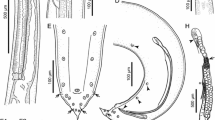Abstract
Neocosmocercella bakeri n. sp. is described from the large intestine of Phyllomedusa vaillantii Boulenger collected in the Caxiuanã National Forest in the Eastern Brazilian Amazon. The new species is easily distinguished from the type-species of the genus, Neocosmocercella paraguayensis Baker & Vaucher, 1983 in possessing a triangular mouth opening with three simple lips (vs three bi-lobed lips and hexagonal mouth opening) and somatic papillae, which are absent in N. paraguayensis. The males of the new species are distinguished by the distribution of the sessile cloacal papillae and the dimensions of the gubernaculum, whereas the females are distinguished by their smaller size and opisthodelphic uterus. This study expands the diagnostic characters of Neocosmocercella Baker & Vaucher, 1983, reports the first species parasitising anurans of the Brazilian Amazon, a new host record for the genus, and the description of the second species of the genus.


Similar content being viewed by others
References
Anderson, C. R., Chabaud, G. A., & Willmott, S. (2009). Keys to the nematode parasites of vertebrates. Archival volume. London: CAB International.
Baker, M. R., & Adamson, M. L. (1977). The genus Cosmocercella Steiner, 1924 (Nematoda: Cosmocercoidea). Canadian Journal Zoology, 55, 1644–1649.
Baker, M. R., & Vaucher, C. (1983). Parasitic helminths from Paraguay IV: Cosmocercoid Nematodes from Phyllomedusa hypochondrialis (Daudin) (Amphibia: Hylidae). Revue Suisse Zoologie, 90, 325–334.
Bursey, C. R., Goldberg, S. R., & Parmalee, J. R. (2001). Gastrointestinal helminths of 51 species of anurans from Reserva Cuzco, Amazónico Peru. Comparative Parasitology, 68, 21–35.
Campião, K. M., Morais, D. H., Dias, O. T., Aguiar, A., Toledo, G. M., Tavares, L. E. R., et al. (2014). Checklist of helminth parasites of amphibians from South America. Zootaxa, 3843, 1–93.
Draghi, R., Drago, F. B., & Lunaschi, L. I. (2015). First report of the genus Neocosmocercella Baker & Vaucher, 1983 (Nematoda: Cosmocercidae) parasitizing amphibians from Argentina. Revista Argentina de Parasitología, 3, 12–15.
Duellman, W. E. (1978). The biology of an equatorial herpetofauna in Amazonian Ecuador. Lawrence, Kansas: Museum of Natural History, University of Kansas.
Frost, D. R. (2016). Amphibian species of the world: an online reference. Version 6.0. New York: American Museum of Natural History. http://research.amnh.org/vz/herpetology/amphibia. Accessed in 13 May 2016.
ICZN. (2012). International Commission on Zoological Nomenclature: Amendment of articles 8, 9, 10, 21 and 78 of the International Code of Zoological Nomenclature to expand and refine methods of publication. Zootaxa, 3450, 1–7.
Vicente, J. J., Rodrigues, H. O., Gomes, D. C., & Pinto, R. M. (1990). Nematóides do Brasil. 2ª parte: nematóides de anfíbios. Revista Brasileira de Zoologia, 7, 549–626.
Acknowledgements
We are grateful to the field team and to Dra. Elane Giese for granting access to the Laboratory of Animal Embryology and Histology of the Federal Rural University of Amazonia and for scanning electron microscopy analyses.
Funding
The financial support for this study was provided by PVE A013/2013 (CAPES/CNPq); “Parasitologia Básica 2010” (CAPES); PIBIC/CNPQ; Productivity Scholarship (CNPQ) to J.N.S.; and PROPESP/FADESP under research proposal PAPQ2016.
Author information
Authors and Affiliations
Corresponding author
Ethics declarations
Ethical approval
All applicable institutional, national and international guidelines for the care and use of animals were followed. Specimens were collected under permits 0004/06 NUC SUPES PA, project “Biodiversity survey of the herpetofauna according to the Research Program on PPBIO eastern Amazonia” and SISBIO 32660-1, project “Amphibian and reptile diversity and associated helminth parasites in the Amazon region”.
Conflict of interest
The authors declare that they have no conflict of interest.
Additional information
This article was registered in the Official Register of Zoological Nomenclature (ZooBank) as urn:lsid:zoobank.org:pub:36419DE7-8B43-4903-84F2-5D2F393B02FA. This article was published as an Online First article on the online publication date shown on this page. The article should be cited by using the doi number. This is the Version of Record.
This article is part of the Topical Collection Nematoda.
Rights and permissions
About this article
Cite this article
dos Santos, A.N., Rodrigues, A.R.O., dos Santos, J.N. et al. A new species of Neocosmocercella Baker & Vaucher, 1983 (Nematoda: Cosmocercidae), a parasite of Phyllomedusa vaillantii Boulenger (Anura: Phyllomedusidae) in the Caxiuanã National Forest, eastern Amazon, Brazil. Syst Parasitol 94, 505–510 (2017). https://doi.org/10.1007/s11230-017-9713-9
Received:
Accepted:
Published:
Issue Date:
DOI: https://doi.org/10.1007/s11230-017-9713-9




